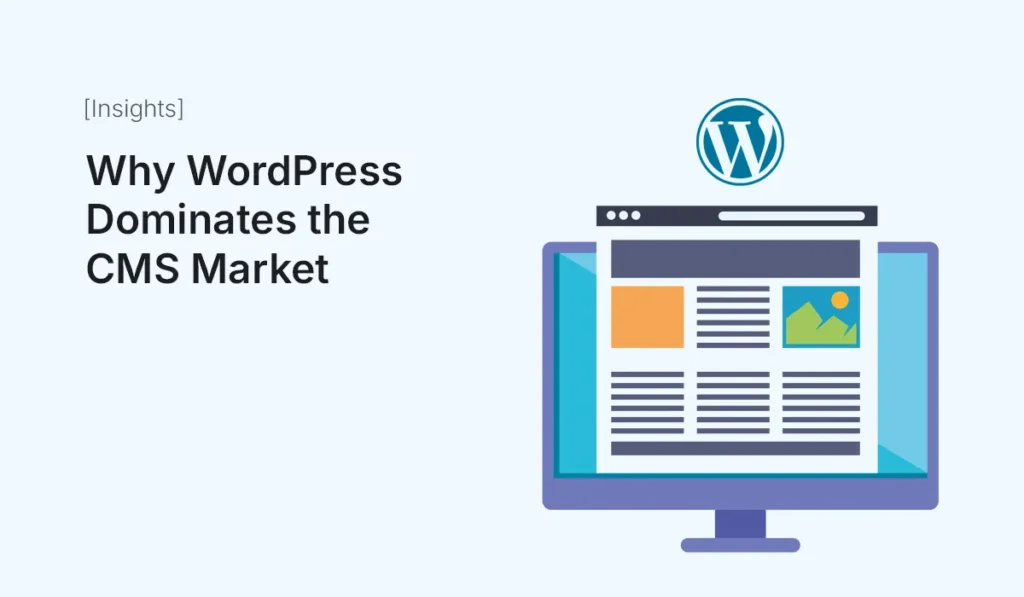Why WordPress Dominates the CMS Market

When it comes to building websites, one name consistently stands out: WordPress. With more than 43% of all websites on the internet powered by it, WordPress has become the go-to choice for individuals, businesses, and organizations worldwide. But why does WordPress dominate the CMS (Content Management System) market when there are so many alternatives like Joomla, Drupal, Wix, or Shopify? In this post, we’ll explore the reasons behind WordPress’s dominance, the advantages it offers, and why it continues to stay ahead of its competitors in 2025. A Brief Look at the CMS Market The CMS market has grown rapidly over the last two decades. Businesses, bloggers, eCommerce owners, and enterprises all need an easy way to publish and manage content online. Clearly, WordPress has built a strong foundation in the digital world. But what makes it so successful? Open Source & Free to Use One of the biggest reasons for WordPress’s success is that it’s open-source software. Anyone can download, use, modify, and distribute it for free. This lowers entry barriers for: Unlike closed platforms like Wix or Squarespace, WordPress gives users full ownership and control of their websites. Unmatched Flexibility and Customization WordPress is more than just a blogging tool—it’s a complete CMS that can power: With over 11,000 themes and 60,000+ plugins, customization possibilities are endless. Businesses can build unique, professional sites tailored to their exact needs. Massive Ecosystem of Themes and Plugins The WordPress ecosystem is unmatched in size: This ecosystem means that any feature you need—from SEO optimization to advanced booking systems—already exists as a plugin. Strong Community Support WordPress has one of the largest open-source communities in the world. This community-driven model ensures WordPress keeps improving while staying free and accessible. SEO-Friendly by Design Search engines love WordPress websites. Why? As SEO is critical for online success, WordPress offers a strong foundation for ranking well in search engines. Scalability for Any Size Website From a personal blog with 100 visitors a month to a corporate site with millions of visitors, WordPress scales beautifully. Examples of major brands using WordPress include: This scalability is one reason why enterprises trust WordPress alongside individuals and small businesses. WooCommerce and the Rise of eCommerce eCommerce is booming, and WooCommerce, the plugin built for WordPress, powers over 28% of all online stores. This integration has made WordPress not just a CMS, but also one of the most popular eCommerce platforms. Mobile-First and Responsive Modern WordPress themes are responsive by default, ensuring websites look great across devices. With mobile traffic dominating the web, WordPress’s ability to adapt makes it future-proof. Cost-Effective for Businesses Building and maintaining a website with WordPress is significantly cheaper compared to proprietary platforms. This makes it accessible to startups and entrepreneurs on tight budgets. Constantly Evolving WordPress evolves with the times: Its adaptability ensures it stays relevant, unlike some CMS platforms that struggle to keep up with modern trends. Strong Security Options While no platform is 100% secure, WordPress provides robust options: This ensures businesses can safeguard their websites without depending solely on developers. Final Thoughts WordPress dominates the CMS market because it’s free, flexible, scalable, SEO-friendly, and backed by a global community. Its ecosystem of themes, plugins, and integrations gives it a clear edge over other platforms. Whether you’re launching a personal blog, running a small business, or managing a large-scale enterprise, WordPress provides everything you need to build and grow a successful website. Its dominance is not just about popularity—it’s about the value and freedom it offers compared to competitors. Ready to experience it yourself? Build your site today and see why WordPress dominates the CMS market with its unmatched power, flexibility, and community support!
HTML vs. React Templates: Pros & Cons

Introduction When building a website, one of the biggest decisions developers and businesses face is choosing between HTML templates and React templates. Both offer unique advantages, but the right choice depends on your project goals, technical requirements, and long-term scalability. In this article, we’ll compare HTML vs. React templates, break down their pros and cons, and help you decide which is the better fit for your next project. What Are HTML Templates? HTML templates are pre-built static layouts made with HTML, CSS, and sometimes JavaScript. They are lightweight, easy to set up, and ideal for straightforward websites such as portfolios, blogs, and landing pages. Pros of HTML Templates Cons of HTML Templates What Are React Templates? React templates are pre-built website templates built with React.js, a popular JavaScript library for building user interfaces. They are dynamic, reusable, and highly scalable—perfect for modern web applications. Pros of React Templates Cons of React Templates Side-by-Side Comparison Feature HTML Templates React Templates Ease of Use Beginner-friendly Requires React knowledge Performance Fast loading for small sites Better for dynamic, complex apps SEO Great for static sites Needs SSR/prerendering Scalability Limited Highly scalable Interactivity Basic (needs extra JS) Advanced interactivity built-in Best For Portfolios, blogs, landing pages Dashboards, SaaS, web applications When to Use HTML Templates When to Use React Templates Conclusion Both HTML and React templates have their place in web development. Ultimately, your choice should depend on project scope, future growth, and your team’s technical expertise. Decide between HTML vs. React templates based on your project needs—whether you need simplicity and speed or scalability and interactivity, there’s a template that’s right for you!
